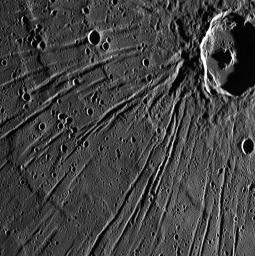This spectacular image contains the crater Apollodorus and some of the Pantheon Fossae structure, a complex system of extensional troughs located near the center of the Caloris basin. Although Apollodorus is located close to the center of Pantheon Fossae, the crater and trough system appear to be unrelated. North is down in this image.
This image was acquired as part of MDIS's high-resolution surface morphology base map. The surface morphology base map will cover more than 90% of Mercury's surface with an average resolution of 250 meters/pixel (0.16 miles/pixel or 820 feet/pixel). Images acquired for the surface morphology base map typically have off-vertical Sun angles (i.e., high incidence angles) and visible shadows so as to reveal clearly the topographic form of geologic features.
The MESSENGER spacecraft is the first ever to orbit the planet Mercury, and the spacecraft's seven scientific instruments and radio science investigation are unraveling the history and evolution of the Solar System's innermost planet. Visit the Why Mercury? section of this website to learn more about the key science questions that the MESSENGER mission is addressing. During the one-year primary mission, MDIS is scheduled to acquire more than 75,000 images in support of MESSENGER's science goals.
Date acquired: July 28, 2011
Image Mission Elapsed Time (MET): 220331898
Image ID: 560776
Instrument: Wide Angle Camera (WAC) of the Mercury Dual Imaging System (MDIS)
WAC filter: 7 (748 nanometers)
Center Latitude: 31.5°
Center Longitude: 165.0° E
Resolution: 115 meters/pixel
Scale: Apollodorus crater is approximately 42 km (26 mi.) in diameter.
Incidence Angle: 83.1°
Emission Angle: 38.3°
Phase Angle: 121.4°
These images are from MESSENGER, a NASA Discovery mission to conduct the first orbital study of the innermost planet, Mercury. For information regarding the use of images, see the MESSENGER image use policy.

 Planetary Data System
Planetary Data System












